There is a lot going on right now in the transportation file in the Lower Mainland, both good and bad news, and I can hardly keep up, never mind blog about it. So while the local radio stations stoked anger a couple of weeks ago about another TransLink “outrage”, I had something completely different to get angry about: this “Fact Scheet” produced by the provincial government in regards to the Massey Tunnel replacement project: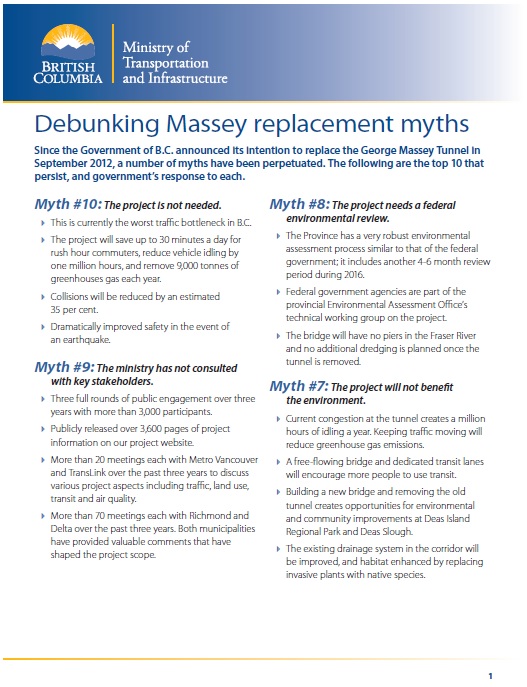
After venting into a Word document, I put it aside and relaxed. Writing is good therapy, and I figured I would edit it up and make use of it later. Anger abated, back of mind, life goes on. Then last week I was triggered to pull it back out by this post by Transportation Economist Stephen Rees (someone you should be reading – his knowledge and insight are unique and powerful), and his writing:
I must admit that when I read it I became almost incoherent with rage.
Amen, Brother.
Why “rage” about a seemingly innocuous two-page fact sheet produced to hard sell a key government project to the business community? Because almost every proclaimed myth-busting point presented on this definitive piece of Government paper is a lie. A stinking pile of bullshit that anyone who has spent any time learning about transportation policy in the western world over the last three decades can smell from a mile away. And it is printed on Government letterhead. I’m angry that either people in the Ministry of Transportation don’t know it is all bullshit, or they do know and are still willing to publish it. I’m not sure which is worse.
That last paragraph may seem inappropriate to some of my readers (Sorry, Mom!), but please let me assure you, I use the term bullshit in the strictly technical sense of the word. And someone needs to start calling this government out on their lies.
The “myths” hit the news two weeks ago when the Minister presented his case for a 10-lane bridge to the relatively receptive audience of the Richmond Chamber of Commerce. At the event, he was suggested to have “busted” some myths about the project, being spread by what he called “rumour-mongers, conspiracy theorists and those with apparently ill-informed opinions”.
Let us look at the Myths seemingly busted:
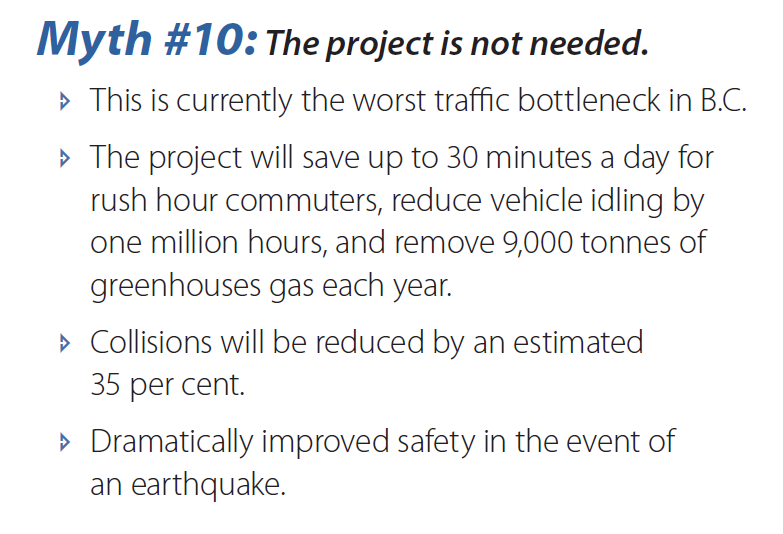
If we define “The project” as a 10-lane high level bridge, then clearly it is not the only solution to the problems presented here. Traffic congestion in the tunnel has been demonstrated to be getting better, not worse, over the last decade, and the Ministry’s own data shows that 87% of vehicles in the tunnel are cars (almost all single-occupant) while more than a quarter of the *people* going through the tunnel are in the 1% of vehicles that comprise the inadequate transit service through the tube. Providing better options for only 15% of the people who use the tunnel would virtually end congestion, leaving a bunch of money left over to finish the work to make the tunnel earthquake safe again. Saying “we need to do something” is not the same as saying “we need to do this thing”. This project is not needed. Myth not busted.
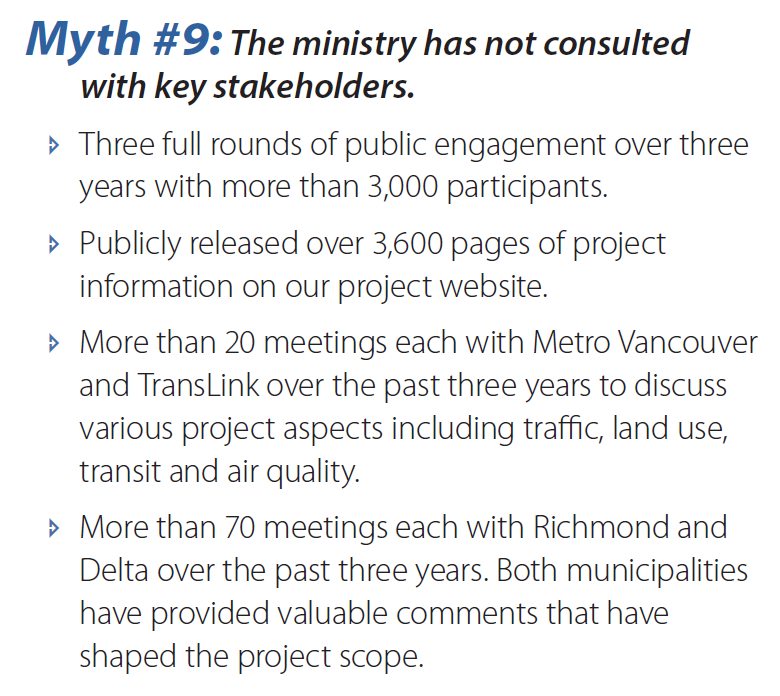 There is no doubt the Ministry has talked to many people, but to say they have “consulted” is quite the stretch. The City where the majority of the project has taken place is claiming they have not been listened to, and are not in favour of the project, the regional government is opposed, as are all of the local governments (save one). No defensible business case has been presented answering for the project. The parts of the “3,600 pages of Project Information” that referred to costing and SWAT analysis were redacted.
There is no doubt the Ministry has talked to many people, but to say they have “consulted” is quite the stretch. The City where the majority of the project has taken place is claiming they have not been listened to, and are not in favour of the project, the regional government is opposed, as are all of the local governments (save one). No defensible business case has been presented answering for the project. The parts of the “3,600 pages of Project Information” that referred to costing and SWAT analysis were redacted.
One way to tell that “consultation” has not occurred: No aspect of the plan has demonstrably been changed to address the concerns of people consulted since this 10-lane bridge solution was first presented to the public. They started with a 10-lane high level bridge solution, and ended at it. Myth not busted.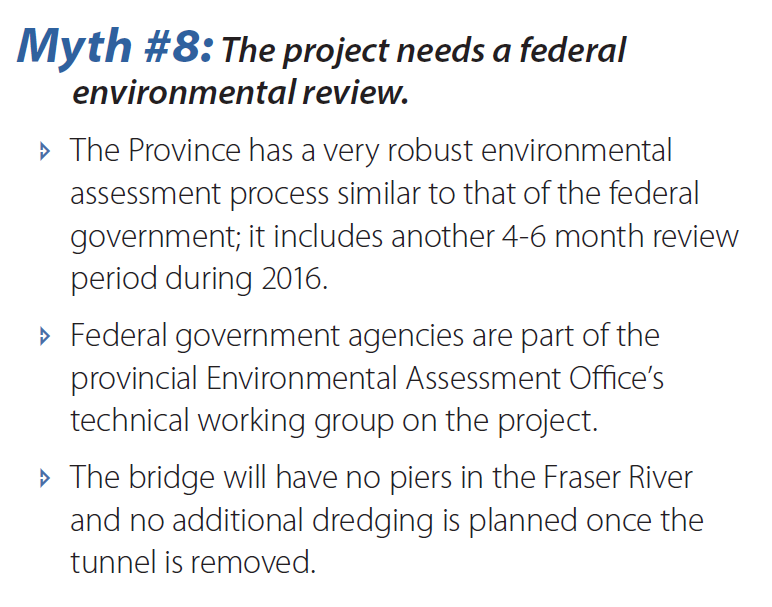
They are right, no Federal Review is required by current legislation (assuming that other accessory projects like removing the old tunnel and re-routing of the BC Hydro line that uses the tunnel are separate projects). This is because the gutting of the Canadian Environmental Assessment Act by the Harper Conservatives in 2012 significantly cut back on Federal Review guidelines. Myth busted, but probably not something to be proud of.
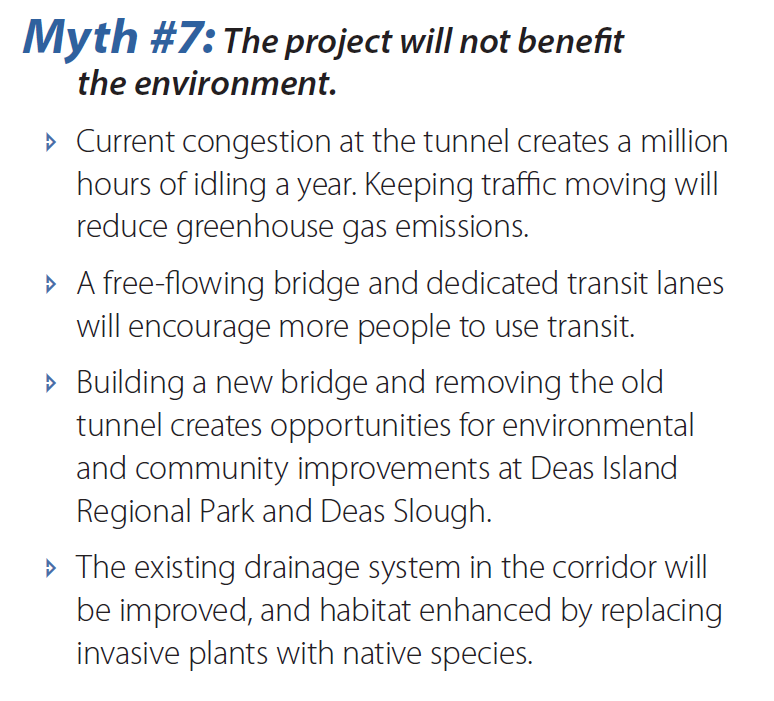
What a steaming pile this is. “keeping traffic moving to reduce GHG emissions” is a perfect example of bullshit: it’s not wrong, it’s just stupid. Ways to reduce GHG impacts of transportation have been studied to death, and yes, idling reduction (depending on conditions) can reduce gas consumption per kilometre, but it does not reduce GHG emissions anywhere near as much as dozens of other available techniques, including modifying trip-making choices, increasing vehicle occupancy rates, shifting (freight and passengers) to more efficient modes, compact community planning, etc. etc. – policies that are directly undermined by this very project! Claiming that “free flowing traffic” induces transit use boggles the mind. The other “improvements” and “enhancements” listed here could easily be funded at a fraction of the cost of building a $3.5Billion bridge, without the boondoggle hanging over it. Why is planting a tree contingent on laying asphalt, what does one have to do with the other? Myth not busted.
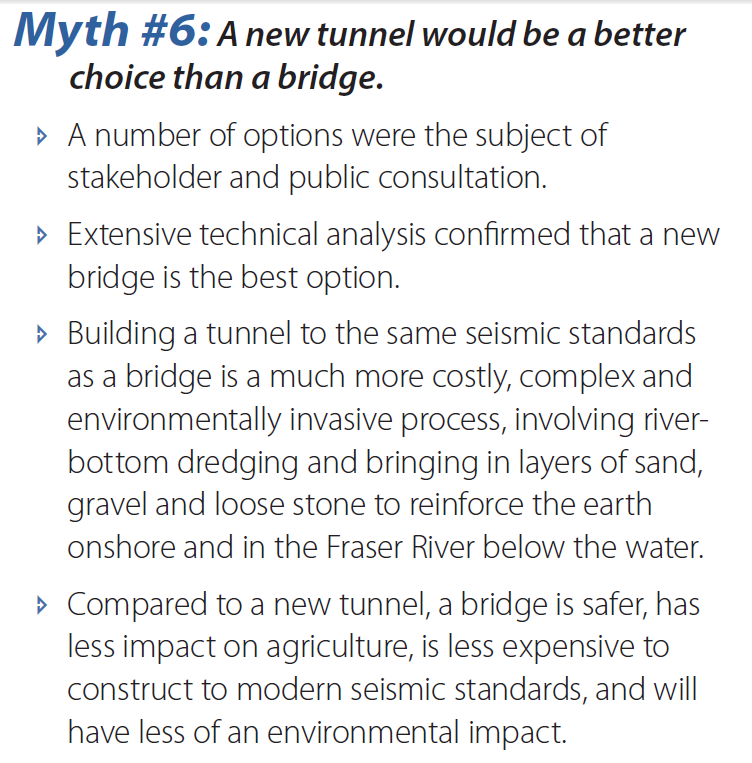 This may very well be true. But you know what is cheaper than building a new tunnel and cheaper than a new bridge? Making the infrastructure you already have work better. One of the more galling parts of this entire project is that no-one seems to be looking at the opportunity cost of a $3.5Billion infrastructure investment – what real improvements could we build to the regional transportation system with that kind of money. Perhaps start here. Myth busted, not that it is relevant to the argument.
This may very well be true. But you know what is cheaper than building a new tunnel and cheaper than a new bridge? Making the infrastructure you already have work better. One of the more galling parts of this entire project is that no-one seems to be looking at the opportunity cost of a $3.5Billion infrastructure investment – what real improvements could we build to the regional transportation system with that kind of money. Perhaps start here. Myth busted, not that it is relevant to the argument.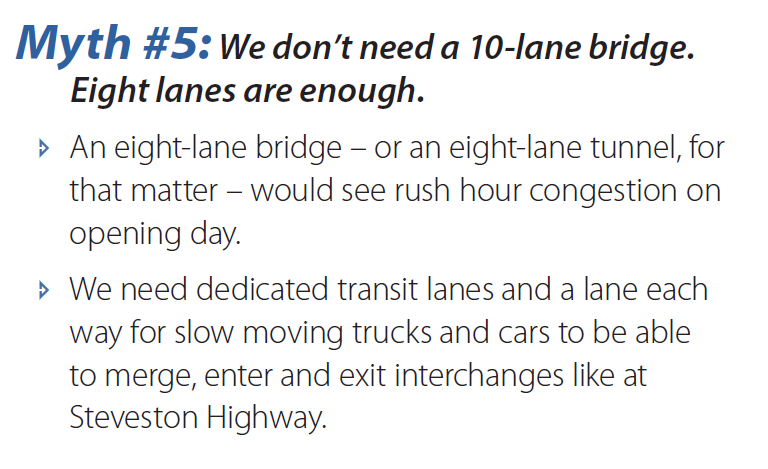
Seriously. The Ministry is arguing that the route that now has 4 lanes will be congested on opening day if it has 8 lanes, but will allow free-flow until 2040 if it has 10 lanes. Chew on that for a bit. Just let the magical thinking sink in. Then remember, these are the guys who projected traffic demand for the Port Mann. Myth not busted.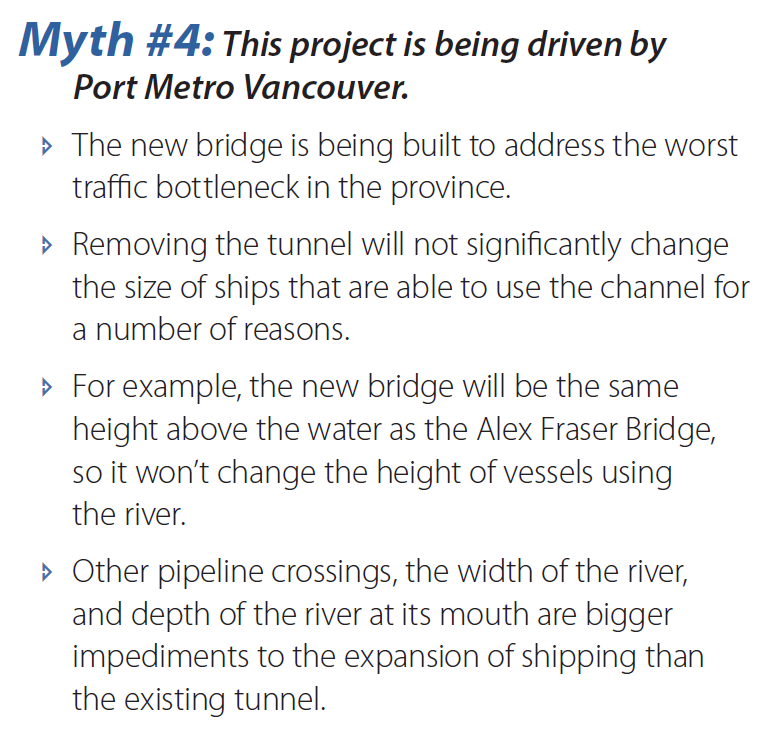
There is a lot of creative work here to not directly address the assertion that is being made. The bottleneck is irrelevant to this point (as we know there are too many other more affordable ways to address a bottleneck that is 85% single occupancy cars). The height of the Alex Fraser is irrelevant as well, as that is not currently a limit to crossing the tunnel. The word “dredging” is not raised at all in this retort, nor the evidence that deeper dredging in the river is a long-established goal of the various port authorities and port operators on the south arm, or that the tunnel is currently the largest impediment to a deeper channel. Myth not busted; Myth deftly avoided.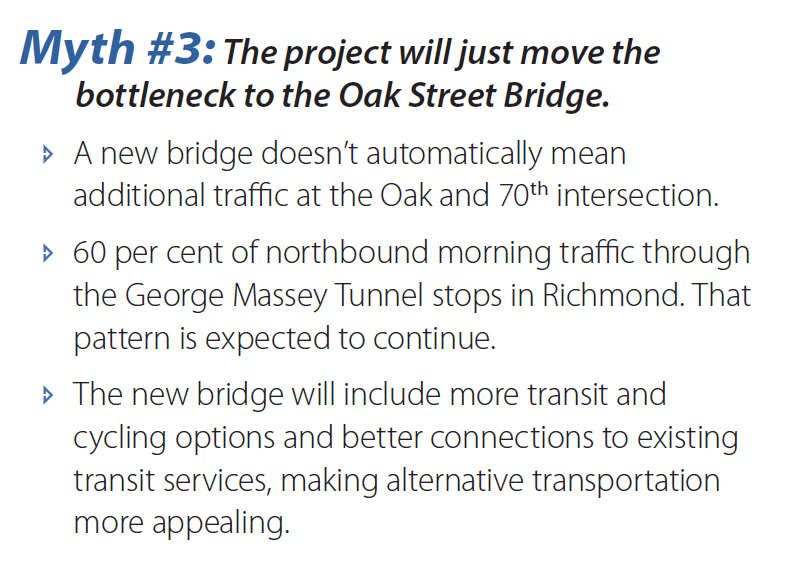
This is the “myth busting” that caused Stephen Rees the most rage, because it is completely separated from reality, the reality that he has spent a distinguished career studying on two continents. There are no transportation planners, transportation economists, transportation engineers, or rational human beings who believe that more than doubling the capacity at the tunnel will not increase traffic congestion at the Oak Street Bridge. Their denial of this basic reality is simply a lie. To get the count of “60% stops in Richmond”, they had to count all of the traffic leaving the 99 to go on the East-West Connector and the Knight Street Bridge as being “Richmond” traffic. And yes, those routes will also become more congested, calling for more future “improvements”, because of the induced demand this project will bring (more on that under Myth #1). Myth not busted.
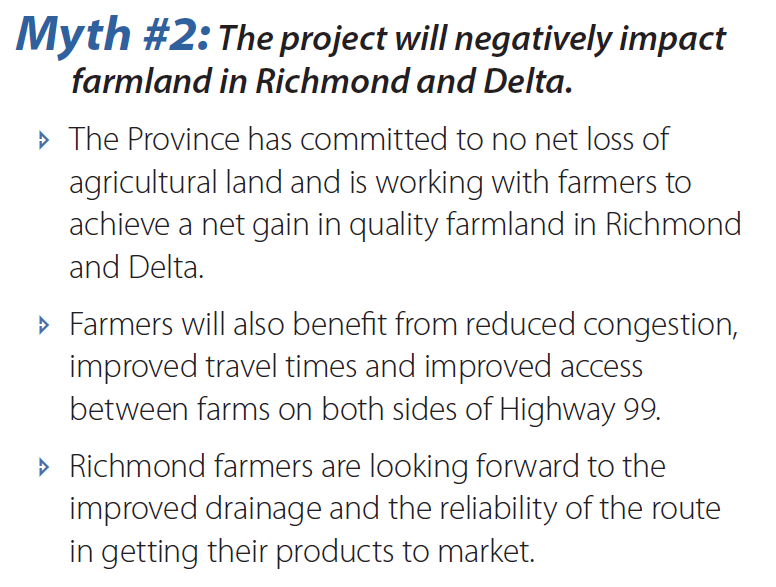 Did you know that Highways are allowed in the ALR? Much of the South Fraser Perimeter Road is actually in the ALR, no exclusion necessary, just compensation paid to the property owner who has his acreage bisected or cut off. So the Ministry can put the entirety of this project on ALR land and claim “no net loss” of ALR land- although admittedly it is hard to farm asphalt.
Did you know that Highways are allowed in the ALR? Much of the South Fraser Perimeter Road is actually in the ALR, no exclusion necessary, just compensation paid to the property owner who has his acreage bisected or cut off. So the Ministry can put the entirety of this project on ALR land and claim “no net loss” of ALR land- although admittedly it is hard to farm asphalt.
I cannot find any evidence (outside of Ministry pieces like this) that farmers on either side of the river support this project, nor does their business case or other consultation material explain how putting hundreds of acres of farmland under asphalt could result in “net gain”. I have read stories of farmers expressing concern about various aspects of the project. I have also heard farmers speaking about the increased pressure on farmland, the inability to afford to farm on farmland with price speculation pushing up farm land prices because of projects such as this which encourage auto-oriented sprawl in valley communities. I have also read about the Port buying up farmland in Richmond to build cross-docking facilities that will be linked to this project with shiny new roads. Myth not busted.
And to top it all off:
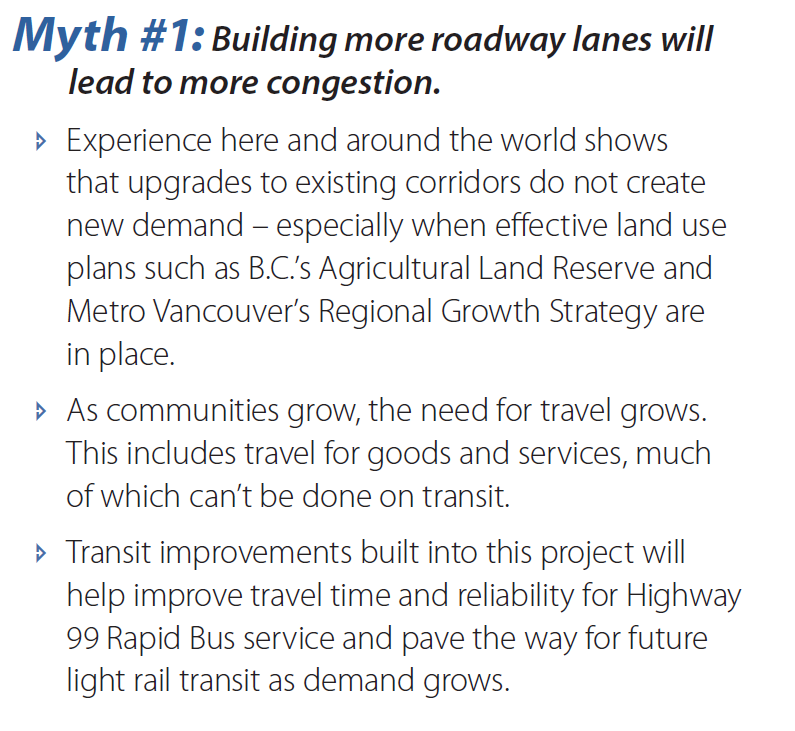
This is pure, unadulterated bullshit. If the Ministry of Transportation can show us an example (from their alleged “experience here and around the world”) from a growing industrialized economy where adding highway capacity has not resulted in increased highway use, they should bottle it and sell it to Los Angeles, or Dallas, or Houston, or Atlanta, or freaking Hanoi. This magic solution to congestion will pay off better than LNG. That increased capacity equals increased congestion is such a well-established concept in transportation planning that it is actually called The Fundamental Law of Road Congestion by the people who study this stuff as an academic discipline. To deny this is to deny gravity, or evolution, or the atomic model. Myth not busted, but supported by a Fundamental Law.
On this blog, I’m trying to be solutions-based. I often write things that sound critical as a search for solutions, as a way to force myself to look deeper at issues, do some research, understand the counter-arguments against my point, so I can do a better job when I have to make a decision. The Q2Q bridge is an example where I am less and less certain about how to move the project the more I learn about it. Although I am still hopeful we can find a good solution, I am increasing cognizant through stages of planning and public consultation of just how complicated a project it is, and that no matter what we do, someone isn’t going to like it. And I’m trying, really hard, to stay realistic and evidence-based on this project. When I point out numerous flaws to one specific approach, it isn’t just to be a boo-bird or support “the forces of NO”, it is to challenge assumptions and try to understand *if* the idea will work, which is often easiest to do by figuring out why it won’t. That is, I suppose, a result of my training in science, where we work to find reasons to reject null hypotheses. Or maybe I’m just a detail-mining jerk.
Then I get confronted with a project like the Massey Tunnel Replacement. This is a project with no reasoned justification, no supported business case, no alignment with any other regional plan or transportation initiative. It is a megaproject that stands in opposition to regional growth plans, regional transportation plans, and provincial and federal GHG reduction plans, and will undermine them all. It’s a bad idea at a bad time, badly presented for bad reasons. It is a bad idea so bad even most of the arguments against it are bad, but are still better than the arguments for it. And this is why I get angry even writing about it.
That is what your money is building, folks, a 10-lane $3.5Billion concrete edifice to bad ideas, now being bolstered by bald-faced lies by people you are paying to tell them to you. If you are not angry about this, you need to start paying attention.
Well said. Thank you
Why don’t we ask the residents of Houston how well a 2.3 billion dollar widening of the Katy Freeway to 23 lanes has worked out?
I must give credit to the government’s chutzpah. Denying the reality of induced demand in an official government communication is a flat-out ballsy move. Or is it just a cynical pander to the low-information voter who believes in “common sense” and cannot be dissuaded from their belief that more lanes = less congestion?
The short term solution is terribly obvious: implement demand-management (time-of-day based) tolling at the tunnel. Spend a couple years finding out how many vehicles really need to use the tunnel at peak periods. I think we’ll find that the situation is not nearly so dire as the government makes out.
Well done Patrick Johnstone. I guess they will try and lie their way out of this.
Thank you Patrick for this myth busting exercise. Minister Todd Stones presentation at the Richmond Chamber Lunch was one of the most frustrating experiences of my life. After listening to what felt like a ” Time Share sales event” for almost 2 hours the public where denied the possibility of speaking to the Minister as he was rushed away by his staff.
The increased dredging of the Fraser river will likely cause the SA:LT WEDGE to move further upstream and could damage the farm land and the young Salmon fry that need fresh water. The location on land at extreme risk of liquefaction is irresponsible.
The lack of cooperation with the Mayors Council and Federal Minister of Transportation is shocking and this time the government is not going to get away with it. People are ready to stand up to their government and stop this ill conceived project.
We can find far better ways to spend 3.5 billion dollars and it is comments like yours that will educate people and motivate them to write their government to protest their tax dollars being wasted on a bridge to no where.
They are pushing this project (As well as others) before election time. So they can say “lokk what we are doing for you and the future. Don ‘t they get it, most countries are moving away frpm fossil fuels. Our provincial leaders are hanging on to dead issues.
Widen the tunnel and put rapid transit down the 99, and have buses go to the staions just like Bridgeport Station. ANGRY yes.
I have a question about your response to myth #5 – currently with counterflow in, the bridge is 3 lanes going one direction and 1 lane in the opposite and it is still quite heavily congested, at least in my experience. I’m wondering if you think the inevitable counterflow infrastructure on an 8-lane bridge is worth it versus a 10-lane bridge, which doesn’t need this added complexity until 2040, according to the BC Ministry data, and will likely prevent many of the accidents we see in counterflow situations today at/in the tunnel?
That being said, I think you do raise many constructive points and I look forward to hearing more of your analysis in the future.
The majority of citizens polled by Insights West, not known as other than a progressive pollster, are reported to be in favour of the construction of the new bridge.
The city of Vancouver must be connected to the southern Metro cities that lie beyond the sacred Agricultural Only Lands by modern road infrastructure. The city of Vancouver and Richmond simply do not have sufficient housing for those here now and those coming. This is just one reason housing is so expensive here. The bridge to some of these fast growing cities is needed to replace a little tunnel that is over sixty years old and it does not have access for cyclists or rapid public transit.
Better and reliable access for travellers going south from the North Shore, Vancouver, Burnaby and Richmond, etc. to the main BC Ferries terminal, as well as the USA is essential and will be welcomed.
There was also resistance to the Eiffel Tower being built and the Lions Gate Bridge. People are creatures of habit and just don’t like any change but in life change is the only certainty.
To Eric and all the others who suffer from noncritical acceptance of this bridge as the only option: you have failed to see this as the most expensive option to taxpayers. Granted, you have to sit in traffic for much too long, but just because you have been presented with a bridge does not mean it is a bridge that will solve your woes. Other MUCH cheaper and less damaging options do exist but have not been discussed by the government for a few years. This is because they have ulterior motives entirely unrelated to congestion. It’s the only explanation for the insanity: the (white) elephant the room is none other than your very own crown corp: Port of Vancouver. Please do more research before you happily agree with government BS.
Curious if you actually drive the tunnel? I’m highly in favour of the bridge build because that commute is awful (1.5 hours today from Delta to Richmond this morning, oh and he buses sit in that too). I can say that the initial addition of the Alex Fraser bridge so many years ago created such a huge traffic relief for a very long time that allowed for our population to expand significantly and help create a lot of the local culture you now enjoy. Odds are the tunnel replacement will serve the same purpose, it’s just not the only thing we need to do. We need other investments in transit, alternative transport and dedicated carpooling lanes too.
What I would like to see is investment in a new bridge, better transit and bike lanes. However, based on the demographic of people using the tunnel/bridge it’s unlikely they’ll get used much. The big thing you are missing is that the 99 is major tourism travel hub for USA travelers, it’s not just a commuter bridge. The tunnels end of life is soon, it’s needs a viable replacement as does the Patullo (which currently has nets to catch breaking pieces of concrete). You, however don’t offer a real solution either…I invite to try an provide, a realistic one at that that address both short term and long term change.
“If the Ministry of Transportation can show us an example (from their alleged “experience here and around the world”) from a growing industrialized economy where adding highway capacity has not resulted in increased highway use”
SFPR. Checkmate.
Governments having been giving a free ride to the automobile companies since the very beginning .Govts pay for all the infrastructure ,emergency response,police,hospitalization of drivers,courts, coroners,etc etc
What other product on the market is catered to like this?
Stats Canada 2005: The Social Costs of Driving that year were $187.5 BILLION
All we get is more pavement, more parking lots and tons of stink NOISE and stress
The auto companies lobbied long and hard to have their products used and to replace rail and buses with their 2 car family concept and speed and power concepts.
Driving has got to be the MOST ignorant selfish thing we do as humans collectively.
First of all, governments don’t pay for $h!t. Tax paying citizens pay. Government is only a conduit through which the money flows.
Second. “Giving a free ride to the automobile…” Seriously? Should we go back to the horse and buggy?
Social costs? What about social benefits? Like being able to get to work. Visit your sick mother. Travel with your family. All the things that make modern life worth living.
Time to join the modern world. Build the best bridge we know how, and get people moving efficiently.
Do 1,000 individual $3,5 million dollar improvements throughout the lower mainland (including the exit into Stevenson going norhtbound on 99 that back up into the the 99 stopping tunnel traffic in the am). How about fixing the Oak and 70th crossing that causes the Oak St bridge to back up….. If we have sooo much money to waste…
Transportation is the economy on wheels. If you see a truck moving goods, then you know our economy is generating revenue.
Efficient moving of goods is how we generate the revenue that allows for us to pay teachers, doctors, police, and cover the infrastructure costs of education and healthcare.
Your piece is seems hyper focused on commuters. Every commuter I’ve spoken to, who uses the tunnel will tell you needs to change.
The bridge is also vital to emergency services that need the accessibility the bridge provides.
I’ve spoken with a paramedic, Al Proden, who can’t wait for this bridge to be built. He told me, “You can’t imagine what it’s like to been stuck in the tunnel and unable to get to an emergency scene.”
I also spoke with the head of the Neil Dubord, Delta Police Chief (and Police Chiefs of Canada) who agrees the bridge is vital to emergency services being able to get to where they need to go.
Can you imagine what it will be like to be able to ride a bike across that bridge?
Quality of life is what this bridge is all about.
I often drive southbound through the tunnel on Friday afternoon when increased ferry and border traffic makes things worse than other days of the week. But the tunnel isn’t the worst part of the trip for me. That “honour” goes to the painful and nerve wracking trip from UBC to the Oak Street Bridge. Compared with that I actually enjoy waiting for the tunnel.
This piece is focused on commuters for one very good reason: take away rush hour commuters and there would be no need for any road expansion anywhere in Metro Vancouver. Heck, take away rush hour and a lot of our roads could be narrowed with no ill effects. Trucks and tradespeople move through the tunnel with ease at all hours of the day EXCEPT rush hour when the roads become clogged with single occupancy vehicles.
Drivers aren’t to blame for the post war world that our grandparents built, the fantasy-land predicated on endless supplies of cheap fuel and land for new and wider roads, but we must realize that we can’t keep making the same mistake over and over again.
Ride a bike across the bridge ?? Really ?? From where? To where? Why?. Emergency Services 🙂 the moment response times for Emergency Services improves, the ‘ government’ will see that Emergency Services are “over staffed” and cut service AGAIN. There is no reason why Emergency services between the tunnel and oak st bridge can’t be handled by services in Richmond, north of the tunnel by Delta, Surrey etc. Other than previous budget and services cuts. Getting to the richmond side of the problem faster changes nothing. Highway 99 is a parking lot during rush hour because, Steveston highway is a parking lot, westminster highway is a parking lot, knight street is a parking lot, oak street is a parking lot, sw marine drive is a parking lot etc. etc. We MUST reduce the volume of single occupancy vehicles commuting down town. A new bridge providing 5 lanes to the next traffic jam solves nothing, look at the Alex Fraser bridge parking lot, if the Alex Fraser bridge was 5 lanes north it would make no difference at all. The infrastructure down line is ALL carying far more than it reasonably can. Solution: NO single occupant vehicles monday to friday 6am to 6pm. On any major arteries. Backed up with…. light rapid transit from North Delta, South surrey, tsawwassen ferry terminal directly to bridgeport station. Continuous Dedicated bus lanes as above. The ONLY steps in the right direction must get entirely rid of single occupancy vehicles. Thats a guaranteed 50% reduction in cars.
Strangely, the current tunnel is a non-issue if you are not the only person in the car. Use of the existing “car pool” lanes gets me through the jam in just a few minutes. If a quarter of those people in single occupancy vehicles paired up there would be no congestion for anyone.
BTW I think Patrick meant “tunnel” when he said “Traffic congestion in the bridge has been demonstrated to be getting better”.
It’s all about mix.
While it’s true that your average 5.7 Hemi or Dodge Charger in their current form will eventually become almost impossible for anyone but the wealthiest idiot to run, Priuses and Teslas are here to stay. In a few decades, given a hydrogen infrastructure and more (much, *much* more) work on control systems, fuel-cell driven, autonomous vehicles could be a reality. None of that is going to reduce desire for personal travelling space, and we’ll still need road infrastructure for thousands of vehicles – just vehicles with no direct emissions and controlled by algorithms to reduce or eliminate congestion.
Building a six-lane bridge or a third tunnel bore could be a sensible response, allowing conventional traffic now while also equipping for the future, but it needs to come with investment in comfortable buses and trains you’d be happy to swap your Mercedes for – spending $3.5bn (make that $5bn) on a hundred-year piece of 20th century kit in 2016 is pure folly.
Dead right and I have been saying the same things. The following was printed in several regional newspapers.
The Editor;
So, just why is the perfectly good Massey Tunnel being replaced by a $3.5 billion bridge?
No, it is not about congestion or rush hour gridlock, in fact the current government does not give a hoot about those issues as recent FOI received by Richmond Councillor, Harold Steves, shows; it is about BC Liberal friends, Port Metro Vancouver and Fraser Surrey Docks lobbying the government for a bridge replacing the tunnel so they can bring larger draught ships up the Fraser to their facilities.
Silly me and I thought that Roberts Bank Super Port was built to service large ships, leaving the environmentally challenged Fraser alone.
Why is Richmond Council worried?
Simple, all the new bridge will do is move gridlock and congestion to Richmond, as roads and highways cannot cope with more traffic.
The new 10 lane mega bridge is the harbinger of endemic gridlock in Richmond; massive development (destruction) of Burns Bog and all ALR lands in Delta, as Metro Port Vancouver is turning the Fraser estuary into a massive commodity port, presently being done by stealth contrary to Metro Vancouver (GVRD) planning.
Those on Delta Council who support this bridge also support massive urban sprawl, traffic gridlock (as will happen in Richmond), the destruction of the ALR in Delta, and massive new tax increases to pay for municipal infrastructure upgrades to cater to the new development.
I am tired subsidizing BC Liberal’s hugely expensive vanity projects; I am tired of paying higher taxes to subsidize BC Liberal friends and insiders grand development plans, seemingly done on the back of an envelope. If Port Metro Vancouver and Fraser Surrey Docks want a new bridge, let them pay for it as well as highway upgrades and a new bridge to Vancouver/Burnaby! It’s only fair.
Let’s bring honesty back into the planning process; honesty which those supporting a new bridge seem to lack!
———————————————————————————————————————–
There is no need for this bridge and it seems the current government is robbing the education Ministry to pay for it.
Just a note, Two weeks ago i drove from South Delta to Vancouver at 5 PM; it took me 50 minutes to get to Alma and Broadway. The major congestion happens when there is an accident and the same thing will happen with the new bridge.
(This came in as an “ASK PAT” from Neil, but really fits the comments section better…)
“Great response to the BC Gov’s Mythical Fact Sheet. They are either full or empty of it !
With regards to stakeholders, BC First Nations have not been asked as yet about the Massey Bridge. As with Lelu Island any major BC project these days is subject to BCFN review and consent whether BC likes it or not.
Statement today regarding Lelu Island –
“If they approve this project, I think (Prime Minister Justin Trudeau) declared war on the people who are concerned about this system,” said Gerald Amos, chair of the Friends of Wild Salmon on behalf of the chiefs assembled.”
http://aptn.ca/news/2016/04/19/bc-chiefs-say-approving-petronas-gas-project-akin-to-declaring-war/“
I have been considering doing something completely different for me, get involved! The replacement bridge for the Massey Tunnel has irked me from the beginning. I have become aware of it since I run in what I call Deas Park (maybe we should now call it Massey Park as well). My first thoughts were about the new noise I would have to face running there. Somehow the clanking of the cars over my head did not seem very inviting for me (and others) to the park.
I live in Kitsilano, and yes there are lots of parks on my side of the Massey Tunnel, but my running partner lives in Delta so we started going there. Over the years I have become quite attached to MY little park and while I didn’t like having to sit in traffic my park made it worthwhile. So much so that I now come out the night before and bypass the waits. Anyway, this brought the new bridge into my awareness. I listened to all that was being said, and I will likely be one of those 1 person car people for quite a while (sorry) but I am old and will die soon I am sure and at least my part of this will have passed.
So then why do I care? Because, frankly, I don’t like being lied to and taken for the fool, it really annoys me! I elected the politicians and I expect they would have the courtesy to remember that and not try to slide things past me like I was stupid. The bridge will bring more traffic and if my elected person doesn’t know this he should read more, not deny things, or lie about the truth. The result will be more traffic at the Oak Street Bridge. I saw this myself, when I was on my way to those tunnel lines. There currently is a long line up of traffic every morning at the Oak Street Bridge now that backs up past Westminster Hwy sometimes. So, assuming that most of the traffic is going to Richmond as stated, it doesn’t matter there still is a back up now. So adding 3 more lanes from the new bridge is not going to reduce this! Or am I missing something????
The other thing that concerns me is that I just read that it will cost $200M to dredge the south arm 2 meters (~7 feet)! That doesn’t take into account the costs of the removal of the existing tunnel or the annual ~$11M of dredging to maintain it. The Port’s proposal of this cost is to suggest that it could be paid for by a combination of Private and “PUBLIC” monies. If we should share in the cost of the dredging, wouldn’t it be a good idea that perhaps those ships (the Port) should share in the costs of any new bridges that they would be benefiting from. To this note, why is the government not suggesting this. They would be making money from the new bridge after all, while I (I mean we) would just be moving a traffic jam down the road.
I fear disruptive technologies like self driving cars will drastically reduce the number of vehicles on the road before the benefits of this investment can be fully realized. It also seems that the real reason for this bridge is to benefit the corporations that need increased port capacity… a cost which should be born by the corporations that benefit.